Encyclopedia
Updated live from Wikipedia, last check: January 08, 2011 02:08 UTC (46 seconds ago)From Wikipedia, the free encyclopedia
| Great Egret | |
|---|---|
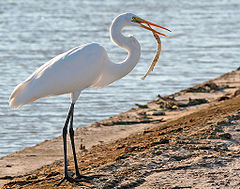 |
|
| Adult in nonbreeding plumage | |
| Conservation status | |
| Scientific classification | |
| Kingdom: | Animalia |
| Phylum: | Chordata |
| Class: | Aves |
| Subclass: | Neornithes |
| Infraclass: | Neognathae |
| Superorder: | Neoaves |
| Order: | Ciconiiformes (disputed) |
| Family: | Ardeidae |
| Genus: | Ardea |
| Species: | A. alba |
| Binomial name | |
| Ardea alba |
|
| Synonyms | |
|
Casmerodius albus |
|
The Great Egret (Ardea alba), also known as the Great White Egret or Common Egret or (now not in use) Great White Heron,[1] and called kōtuku in New Zealand, is a large egret. Distributed across most of the tropical and warmer temperate regions of the world, in southern Europe and Asia it is rather localized. In North America it is more widely distributed ubquitously across the sun belt states in the United States. It is sometimes confused with the Great White Heron in Florida, which is a white morph of the closely related Great Blue Heron (A. herodias). Note however that the name Great White Heron has occasionally been used to refer to the Great Egret.
Contents |
Description
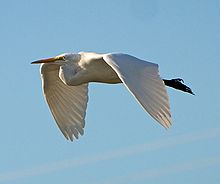
The Great Egret is a large bird with all-white plumage that can reach one meter in height and weigh up to 950 grams (2.1 lb). It is thus only slightly smaller than the Great Blue or Grey Heron (A. cinerea). Apart from size, the Great Egret can be distinguished from other white egrets by its yellow bill and black legs and feet, though the bill may become darker and the lower legs lighter in the breeding season. In breeding plumage, delicate ornamental feathers are borne on the back. Males and females are identical in appearance; juveniles look like non-breeding adults. It is a common species, usually easily seen. It has a slow flight, with its neck retracted. This is characteristic of herons and bitterns, and distinguishes them from storks, cranes, ibises and spoonbills, which extend their necks in flight.
The Great Egret is not normally a vocal bird; at breeding colonies, however, it often gives a loud croaking cuk cuk cuk.
Systematics and taxonomy
Like all egrets, it is a member of the heron family, Ardeidae. Traditionally classified with the storks in the Ciconiiformes, the Ardeidae now, under the International Ornithological Congress, are closer relatives of pelicans and belong in the Pelecaniformes instead. The Great Egret – unlike the typical egrets – does not belong to the genus Egretta but together with the great herons is today placed in Ardea. In the past, however, it was sometimes placed in Egretta or separated in a monotypic genus Casmerodius.
Subspecies
There were four subspecies in various parts of the world, which differ but little. Differences are bare part coloration in the breeding season and size; the largest A. a. modesta from Asia and Australasia is now considered a full species, the Eastern Great Egret (Ardea modesta). The remaining three subspecies are:
Ecology and status
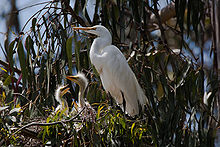
The Great Egret is partially migratory, with northern hemisphere birds moving south from areas with cold winters. It breeds in colonies in trees close to large lakes with reed beds or other extensive wetlands. It builds a bulky stick nest.
Although generally a very successful species with a large and expanding range, the Great Egret is highly endangered in New Zealand, with only one breeding site at Okarito Lagoon.[2][3] In North America, large numbers of Great Egrets were killed around the end of the 19th century so that their plumes could be used to decorate hats. Numbers have since recovered as a result of conservation measures. Its range has expanded as far north as southern Canada. However, in some parts of the southern United States, its numbers have declined due to habitat loss. Nevertheless, it adapts well to human habitation and can be readily seen near wetlands and bodies of water in urban and suburban areas. In 1953 the Great Egret in flight was chosen as the symbol of the National Audubon Society, which was formed in part to prevent the killing of birds for their feathers.[4][5]
They are Protected in Australia under the National Parks and Wildlife Act, 1974.
The Great Egret is one of the species to which the Agreement on the Conservation of African-Eurasian Migratory Waterbirds (AEWA) applies.
Food
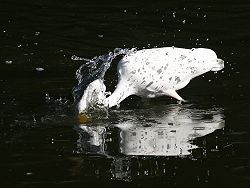
The Great Egret feeds in shallow water or drier habitats, feeding mainly on fish, frogs, small mammals, and occasionally small birds and reptiles, spearing them with its long, sharp bill most of the time by standing still and allowing the prey to come within its striking distance of its bill which it uses as a spear. It will often wait motionless for prey, or slowly stalk its victim.
Though it might appear that they feed on the parasites off buffalos, they actually feed on leaf hoppers, grass hoppers and other insects which are stirred open as buffalos move about in water.[6]
In human culture
The Great Egret is depicted on the reverse side of a 5-Brazilian Reais banknote and on the reverse side of a New Zealand $2 coin.
Different views & aspects
 |
 |
 |
 |
 |
 |
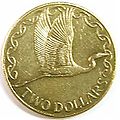 |
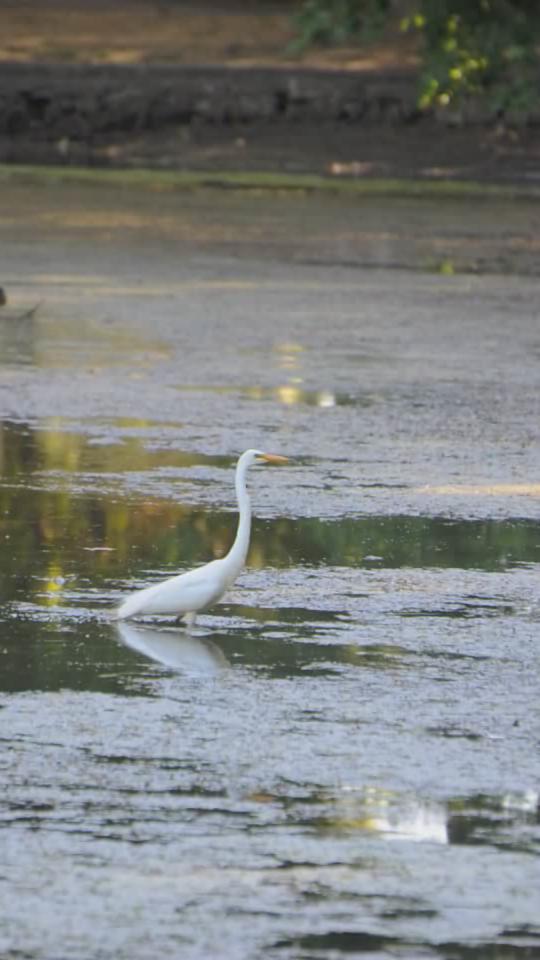 |
 In flight, at Lake Monger |
Footnotes
- ^ So for instance Thomas Bewick, A History of British Birds Newcastle, 1816, vol. II, 52; B. Bruun, The Hamlyn Guide to Birds of Britain and Europe, London, 1970, 36.
- ^ Kotuku, the white heron
- ^ Native Fact sheet, Kotuku Wellington Zoo
- ^ Audubon Timeline
- ^ Historical Highlights: Signature Species
- ^ The Time of the Buffalo by Tom McHugh, Victoria Hobson, page 232
References
- BirdLife International (BLI) (2008). Casmerodius albus. In: IUCN 2008. IUCN Red List of Threatened Species. Downloaded on 18 December 2008.
- Peterson, Roger T. Peterson Field Guides: Eastern Birds. 4th ed. New York: Houghton Mifflin. 102.
- Snow, David W.; Perrins, Christopher M.; Doherty, Paul & Cramp, Stanley (1998): The complete birds of the western Palaearctic on CD-ROM. Oxford University Press. ISBN 0192685791
External links
- The Great White Egret Image documentation
- Great Egret Information - Cornell Lab of Ornithology
- Great Egret Information and Photos - South Dakota Birds and Birding
- Great Egret Information - USGS Patuxent Bird Identification InfoCenter
- Species Field Guide on Flickr
Wikispecies
Up to date as of January 23, 2010From Wikispecies
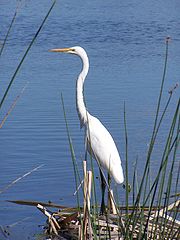
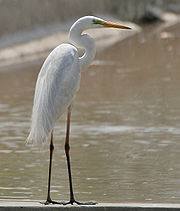
Main Page
Cladus: Eukaryota
Supergroup: Unikonta
Cladus: Opisthokonta
Regnum: Animalia
Subregnum: Eumetazoa
Cladus: Bilateria
Cladus: Nephrozoa
Cladus: Deuterostomia
Phylum: Chordata
Subphylum: Vertebrata
Infraphylum: Gnathostomata
Superclassis: Tetrapoda
Classis: Aves
Subclassis: Carinatae
Infraclassis: Neornithes
Parvclassis: Neognathae
Ordo: Ciconiiformes
Familia: Ardeidae
Subfamilia: Ardeinae
Genus: Ardea
Species: Ardea
alba
Subspecies: A. a. alba -
A. a. egretta -
A. a. melanorhyncha -
A. a. modesta
Name
Ardea alba Linnaeus, 1758
Synonymns
- Egretta alba
- Casmerodius albus
References
- Systema Naturae ed.10 p.144
- ITIS TSN:554135
Vernacular names
English: Great Egret
Español: Garza Blanca
Հայերեն: Տառեղ մեծ սպիտակ
日本語: ダイサギ(大鷺)
Polski: Czapla biała
Português: Garça-branca-grande
Русский: Большая белая цапля
中文: 大白鹭
| For more multimedia, look at Ardea alba on Wikimedia Commons. |
